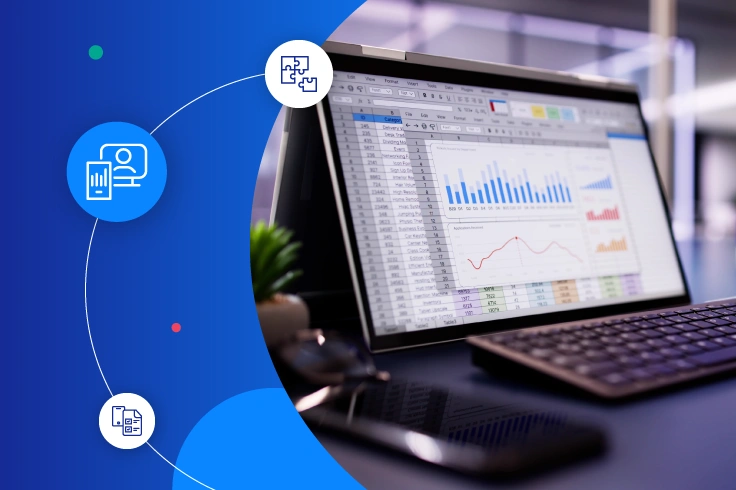What is EDI Integration? Types, Benefits and Alternatives

EDI integration is like the engine powering up modern supply chains. With the right tools and processes in place, businesses can seamlessly exchange critical documents, optimize operations, and reduce manual work. Whether you're looking to modernize your processes or explore new ways of exchanging data, understanding EDI integration is a foundation for staying efficient and competitive.
What is EDI?
EDI (Electronic Data Interchange) is a digital system that enables the automated exchange of business documents, such as purchase orders, invoices, and shipping notices, between trading partners in a standardized format.
By replacing manual, paper-based processes, EDI speeds up processes, minimizes errors, and enhances supply chain efficiency. To dive deeper into how EDI works and its key benefits, check out our detailed guide on What is EDI.
What is EDI Integration?
EDI integration enables the exchange of electronic business documents between partners by connecting a company’s internal systems with an EDI platform. It facilitates near real-time data sharing, reducing manual work, and improving overall efficiency.
In practice, EDI integration connects your internal processes - like accounting, inventory management, logistics and order processing - with external partners through a standardized electronic format. This integration ensures that e-documents are automatically generated, sent, and received without manual input. The result is a streamlined workflow that reduces errors, shortens processing times, and boosts business agility.
7 Benefits of EDI Integration

1. Simplified EDI Onboarding and Migration
Managing the EDI onboarding process or migrating new business partners is another key benefit of EDI integration. When new partners join your supply chain, it can be challenging to ensure seamless document exchanges without a standardized system in place. EDI simplifies this process by automating partner setup, so businesses can easily onboard new partners and start exchanging documents without delay.
This automation reduces the friction of working with new trading partners, improving collaboration and minimizing the time spent manually integrating their systems. It’s especially helpful for businesses that frequently work with new vendors or clients.
2. Eliminating Paper Documentation
By integrating EDI, businesses can completely eliminate paper documentation, reducing both management costs and the environmental impact. Paper-based systems are not only slow but also expensive to manage and store. EDI enables businesses to go paperless, accelerating document flow, cutting down on physical storage needs, and reducing the overall cost of document management.
Going digital with EDI enhances document accessibility while reducing the time spent on administrative tasks like filing, scanning, or retrieving paper documents. Additionally, less physical space and fewer resources are needed to store or handle paper records.
3. Reducing Time-Consuming, Low-Value Tasks
Manual data entry and paperwork are tedious, low-value tasks that consume significant employee time and energy. EDI integration automates these processes, freeing up employees to focus on more strategic, value-added activities. By reducing the burden of manual paperwork, companies can allocate their human resources to higher-priority initiatives like customer service or process improvement.
Employees benefit from reduced stress and improved productivity, as EDI handles repetitive tasks, streamlining their workflow. Automating low-value tasks also reduces human error, ensuring greater accuracy in data handling.
4. Optimization of Commercial, Purchasing, and Administrative Departments
For companies offering or buying goods, EDI integration optimizes operations across commercial, purchasing, and administrative departments. By automating document exchanges such as purchase orders and invoices, businesses can increase efficiency and improve coordination between teams. Delays are eliminated, communication improves, and decision-making is enhanced thanks to real-time data accessible to all departments.
The automation also improves supplier relationships by ensuring that purchase orders and payments are handled more efficiently. For companies managing complex supply chain processes, EDI offers an organized, streamlined approach that simplifies administrative workflows.
5. Increased Data Precision and Reduced Human Errors
One of the primary benefits of EDI integration is the significant reduction in human errors during data exchange. Manual document processing can lead to costly mistakes, such as incorrect pricing, inventory levels, or shipping details. EDI automates these processes, ensuring that data is exchanged accurately and consistently between partners.
Increased precision in data exchange leads to better decision-making, faster transaction processing, and stronger customer relationships. Businesses that rely on timely and accurate data to operate will benefit greatly from EDI’s ability to eliminate errors, ensure data integrity, and enable clearer, more efficient communication with customers.
6. Supply Chain Digitization and Sustainability Potential
EDI integration plays a crucial role in the digitization of supply chains, eliminating the need for manual, paper-based processes. By adopting EDI, businesses can automate document exchanges, reducing their carbon footprint and promoting sustainability. With digital communication, the entire supply chain becomes more efficient, minimizing paper waste and transportation-related emissions from physical documents.
Additionally, digitization enables better tracking and reporting of resources, making it easier to implement eco-friendly practices across the supply chain. Businesses that prioritize sustainability can leverage EDI to streamline operations while aligning with ESG goals.
7. Real-Time Commercial and Fiscal Alignment
EDI integration enables real-time data exchange between trading partners, keeping both commercial and fiscal information aligned. Whether it’s order status, invoice payments, or tax compliance, EDI allows businesses to update documents instantly and track their status in real time. This fosters greater transparency and ensures that both parties have accurate, up-to-date information.
By aligning financial and operational data, EDI helps companies avoid discrepancies and disputes, ultimately improving the business relationship between partners. Timely, automated updates prevent delays and ensure smoother financial reconciliation across the supply chain.
How EDI Integration Works.
EDI integration connects two businesses’ internal systems, enabling them to exchange data automatically. For EDI integration to function, both parties must agree on a transmission protocol and message formats and ensure that their ERP systems can export and import EDI messages. The integration also requires mapping the data into EDI formats and then converting it back into the ERP system’s format for further processing.
While this direct integration between companies is possible, the standard practice today is to rely on an EDI provider. These third-party services, like those provided by Comarch, handle the technical complexities, such as ensuring secure data transmission, managing document formats, and facilitating connections between different systems.

Step 1: Assessing Your Requirements
The first step in any EDI integration project is identifying what processes need to be automated and understanding the technical parameters of your ERP system. This includes evaluating your internal capacity, identifying potential EDI partners, determining the required document formats, and estimating the volume of messages you expect to exchange.
When considering your EDI partners, you will likely find two main categories:
- EDI Integrating Partners – These partners have the technical infrastructure in place to exchange EDI messages directly with your system. For these partners, you’ll need to establish communication protocols, define document formats, and set up secure connections.
- EDI Web Partners – Some partners may not have EDI capabilities and will need to use EDI Web platforms to exchange documents. These platforms allow partners to send and receive EDI messages without direct integration. It simplifies the process for companies without EDI systems, while still maintaining the benefits of automated data exchange.
Step 2: Choosing an EDI Provider
Once you have your requirements, it’s time to choose an EDI provider that aligns with your needs. You’ll want to consider not only the provider’s ability to meet your current technical requirements but also how scalable their solution is to accommodate future growth. Support, pricing models, and ease of onboarding new partners are also key factors to consider in this phase.
Step 3: Planning Implementation
In this stage, a clear project plan is developed, outlining priorities and timelines. The company has to decide the order in which partners will be onboarded and ensure that all technical requirements are aligned. A smooth implementation plan helps prevent delays and ensures that the transition to EDI is smooth for all parties involved.
The right provider can support you during this phase by offering expertise in selecting the right integration approach and ensuring compatibility with existing systems. Comarch also helps map out the process, define technical requirements, and assist in coordinating with partners to ensure a smooth and efficient EDI setup.
Step 4: Technical Implementation
During the technical implementation, businesses must agree on transmission channels, protocols, and message formats. This step also includes organizing and overseeing testing phases, running parallel EDI and manual processes, and eventually moving to full go-live. Depending on the complexity of your EDI integration approach, your level of involvement may vary, but thorough testing and validation are essential to avoid disruptions.
During the technical implementation phase, the EDI provider supports you every step of the way, from setting up the infrastructure to configuring the necessary communication protocols. They strive to ensure that the entire EDI migration and launch process is efficient, minimizing disruptions and ensuring a seamless integration with the company’s existing systems.
Step 5: Ongoing Operation
Once the EDI system is live, continuous monitoring guarantees everything operates smoothly. Over time, adjustments may be necessary as business needs change or partners require new document types. Monitoring ensures that any errors are detected early and dealt with before they cause issues. Regular updates to the system keep the integration efficient and adaptable.
A good EDI provider offers monitoring tools that track the system's performance and ensures everything is working properly, providing real-time alerts and resolving any issues promptly to maintain problem-free operations.
Technical Workflow: How EDI Documents Are Exchanged
EDI integration follows a well-defined technical workflow:
- Export of Data: The sender exports a business document, such as a purchase order, from their in-house system.
- Data Transformation: The document is converted into the appropriate EDI format using EDI mapping or transformation software.
- Validation: EDI conversion software ensures the document complies with agreed-upon EDI standards.
- Transmission: The EDI document is transmitted via a secure protocol (e.g., SFTP, HTTPS, AS2/AS4) to a value-added network (VAN) or directly to the recipient.
Receipt and Processing
In any type of EDI integration, the first step in receiving an EDI document is typically an acknowledgement of receipt. In AS2-based communication, this is done through an MDN (Message Disposition Notification), confirming whether the document was successfully received. In AS4, receipt is confirmed with a Receipt message at the messaging protocol level. These acknowledgements occur before any further verification or import into the internal system.
Once the document is received, the next phase is the processing of the data, which includes importing the document into the internal system for further validation.
A good EDI system will also monitor the application statuses, meaning that even after the document is imported, the process doesn't end. If, for example, the internal system accepts or rejects the document, this status is communicated back to the sender, ensuring transparency and accuracy in the exchange.
Different Types of EDI Integration
Direct EDI Integration (Point-to-Point)
Direct EDI integration, also known as point-to-point integration, establishes a direct connection between two business partners. This type of integration typically uses secure communication protocols like AS2/AS4 to create a private, secure line for document exchange. Both parties are responsible for maintaining the connection, ensuring that all transmissions adhere to the agreed-upon EDI standards.
This method provides real-time data transfer and enhanced control over the EDI process, as businesses directly manage the connection without intermediaries. Direct EDI is often a good choice when exchanging documents with a limited number of key business partners, where stable, point-to-point connections can be efficiently maintained.
Pros:
- Real-time data exchange and communication
- No third-party fees or delays
- Complete control over the EDI process
Cons:
- Requires significant technical resources for setup and maintenance, including responsibility for the security-related issues
- Limited scalability for companies with multiple partners
Indirect EDI Integration
Indirect EDI integration relies on a third-party provider, often called EDI via VAN or EDI Network Services Provider, to facilitate document exchanges between businesses. Instead of a direct connection between partners, documents are routed through the VAN, which handles the transmission, translation, and validation of EDI documents.
This type of EDI integration can be beneficial for businesses of any size, particularly those working with hundreds or thousands of business partners. However, there are added costs associated with using a VAN, and reliance on a third party can slow down communication. With Comarch EDI, costs are typically lower than with direct EDI when exchanging data with multiple partners or handling large volumes of documents, and transmissions occur immediately.
Pros:
- Easier to manage for businesses with any level of internal resources
- Lower upfront investment in infrastructure
- Ideal for companies with hundreds or thousands of partners
- Faster implementation and deployment
- Access to deep expertise in EDI standards for different industries and geographic regions, such as retail, automotive, healthcare, or banking, across Europe, Asia, North America, or the Middle East
- AI-powered automapping tools that speed up EDI integration and implementation by automatically aligning data formats and mapping fields, minimizing manual setup and ensuring faster go-live.
Cons:
- Less control over the process
Different Methods of EDI Integration

EDI via Secure Protocols
AS2/AS4 (Applicability Statement 2/4) are secure protocols that enable the direct exchange of EDI documents over the Internet. Businesses using AS2 or AS4 can establish a point-to-point connection, ensuring that documents are transmitted securely and quickly. They allow real-time communication between partners and are often used by larger organizations with high transaction volumes or those looking for greater control over their EDI operations.
Web EDI
Web EDI is a cloud-based solution that allows businesses to exchange EDI documents through a web portal. This method is especially useful for smaller companies or those with fewer EDI transactions, as it doesn’t require extensive technical infrastructure. Partners can log into the portal to send and receive documents, making it a cost-effective solution for businesses that don’t have the resources for traditional EDI methods.
Mobile EDI
Mobile EDI allows businesses to send and receive EDI documents via mobile devices. As more companies adopt mobile-friendly solutions, Mobile EDI offers increased flexibility and convenience, particularly for businesses that operate across multiple locations or have remote teams. Mobile EDI platforms often include tracking and notification features, making it easy to monitor the status of document exchanges on the go.
Different types of EDI Implementations
| Type of EDI Implementation | Description | Pros | Cons | Best For |
| In-House EDI | In-house EDI involves a company building, maintaining, and managing its own EDI infrastructure, including software, hardware, and staffing. |
|
| Large companies with high transaction volumes and huge dedicated IT teams |
| Managed EDI | It involves a third-party provider managing the entire EDI process, including document exchange, integration, and troubleshooting, either through a cloud-based solution (EDIaaS) or as a comprehensive outsourced service. |
|
|
|
| Integration Platform as a Service (iPaaS) | iPaaS offers a cloud-based platform for managing EDI and other integrations, enabling seamless communication between various systems, applications, and data sources. |
|
| Companies needing complex integrations and multi-system connectivity |
Alternatives to EDI Integration
While EDI remains a powerful tool for automating business document exchanges, there are other integration methods that offer distinct benefits depending on your needs.
EDI vs API
Both EDI and Application Programming Interfaces (APIs) play important roles in modern data exchange. While EDI is a widely adopted method for exchanging structured documents in a standardized format, APIs provide a flexible, real-time communication channel for continuous data flow. Rather than viewing APIs and EDI as distinct solutions, Comarch Integration Platform uses both technologies in harmony.
APIs facilitate real-time updates such as inventory levels or shipment tracking, while EDI remains effective for batch processing and ensuring compatibility across industries. By leveraging both, businesses can achieve greater efficiency, flexibility, and seamless integration with modern systems.
Cloud-Based Integration Platforms
Cloud-based integration platforms, often referred to as Integration Platform as a Service (iPaaS), provide a centralized hub for connecting various systems, applications, and partners. These platforms can handle a wide range of integration methods, including both EDI and APIs, while offering scalability and ease of use. iPaaS solutions are ideal for companies that need to integrate multiple business processes across different systems.
Comarch e-Invoicing is a cloud-based platform that seamlessly integrates internal and external data with suppliers, customers, and service providers. It’s compliant with e-invoicing regulations in over 60 countries, offers business validations, and automation features, ensuring smooth document exchange and error reduction across different formats.
Indications Your EDI Integration Is Broken
When your EDI system starts showing signs of inefficiency, it might be time to consider an EDI migration or switch EDI provider. Outdated systems can lead to numerous issues, including lack of connectivity to backend systems, reliance on manual interventions, or constant maintenance of custom scripts. If you notice these problems, it’s a clear signal to change your EDI service and move toward a modern solution that can handle both batch and real-time integrations.

Switching to a more agile system can improve your ability to integrate EDI documents with back-office applications and automate workflows. By embracing a new integration platform, you not only improve data accuracy but also gain flexibility, helping your business stay competitive in the long term.
Key Takeaways:
- EDI must support integration with various ERP systems used by customers, ensuring seamless data exchange across platforms.
- Effective EDI solutions go beyond the standard by including business-specific validations, ensuring data integrity and compliance with internal processes.
- EDI solutions should enable accurate data matching between related documents, ensuring consistency and reducing errors in transactions.
- With the rise of mandatory e-invoicing, EDI providers must ensure the legal exchange of invoices, adhering to regulations and ensuring compliance in every transaction.
Looking for an EDI Integration Provider?
EDI integration is a powerful tool that helps businesses streamline operations, reduce costs, and enhance supply chain efficiency. By automating document exchange and minimizing errors, EDI is changing how companies communicate with their partners. Whether you're considering in-house solutions, managed services, or cloud-based platforms, there’s an EDI option to fit your business needs.
At Comarch, we offer Comarch EDI, a cloud-based platform designed to simplify and secure your document exchanges. Ready to optimize your supply chain and improve communication with trading partners? Learn more about Comarch EDI today, or contact our experts for a non-binding consultation.


